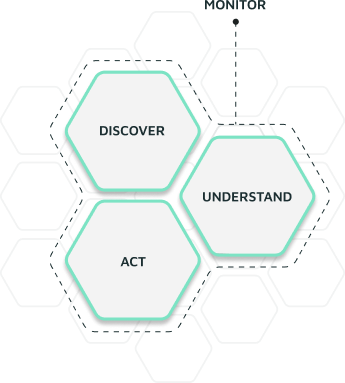


Integrate: Deploy process mining across ERP sustainability modules, IoT sensors, and ESG platforms to automate data collection for emissions, water, waste, and compliance. This removes data silos and ensures a reliable ESG reporting source.
Discover: Identify inefficiencies like missing emissions data, inconsistent waste tracking, and reporting delays. Process mining pinpoints manual bottlenecks, redundant workflows, and compliance risks.
Understand: ESG inefficiencies often stem from manual errors, fragmented data, or outdated monitoring. Delays may result from slow approvals, missing disclosures, or inconsistent reporting. Addressing these issues improves compliance, reduces errors, and streamlines reporting.
Act: Automate emissions tracking, waste monitoring, and ESG compliance validation using AI-driven anomaly detection and process automation, reducing errors and improving data accuracy.
Monitor: Use real-time ESG dashboards to track key metrics, trigger compliance alerts, and enable proactive sustainability improvements.



Integrate: Connected supplier management and ESG tracking platforms with process mining to assess sustainability compliance, carbon footprint impact, and regulatory adherence.
Discover: Identified non-compliant suppliers, high carbon-emitting procurement practices, and inefficiencies in sustainable sourcing strategies. Data revealed supply chain segments with excessive transportation emissions and unnecessary waste.
Understand: Assessed supplier sustainability ratings, green certification adherence, and regulatory requirements. Found that a lack of standardized sustainability metrics led to inconsistent compliance monitoring.
Act: Implemented automated supplier sustainability scoring, introduced preferred supplier programs for eco-certified vendors, and optimized procurement routes to lower emissions and transportation inefficiencies.
Monitor: Used dashboards to track supplier compliance, sustainability progress, and emissions data, ensuring continuous improvement in green procurement. AI-driven insights flagged areas for further carbon footprint reductions.



Connect the ESG processes with the out-of-the-box connector for sustainability management systems. Configure relevant KPIs, including carbon footprint and ESG compliance rates.
Process Mining reveals inefficiencies in energy use and waste management. Further analysis identifies specific operations and facilities contributing to high emissions.
Implement energy-saving initiatives, optimize waste management processes, and engage suppliers with better ESG practices.
Monitor the metrics carbon footprint reduction and ESG compliance to ensure continuous improvement in sustainability efforts.



Analyze water usage data across all production processes using process mining tools. Identify critical points where water is used excessively or wasted.
Identify processes with high water consumption and pinpoint inefficiencies and leaks. Study historical patterns to understand usage fluctuations and peak times.
Implement water-saving technologies, optimize production schedules, and repair leaks to reduce water usage. Introduce water recycling and reuse systems to minimize fresh water consumption.
Continuously monitor water consumption metrics to ensure sustained water efficiency. Use sensors and IoT devices to track real-time water usage and detect anomalies.



Map out waste generation and management processes to identify areas of high waste output. Use process mining to create a detailed overview of waste sources and disposal methods.
Analyze the types of waste generated and the efficiency of current waste management practices. Assess the environmental impact of each type of waste and identify major contributors.
Implement waste reduction strategies, enhance recycling processes, and engage with suppliers to reduce packaging waste. Develop programs to reduce, reuse, and recycle waste materials.
Track waste generation and recycling metrics to ensure continuous improvement in waste management practices. Set up dashboards to visualize waste trends and progress towards goals.



Analyze energy consumption patterns across various operations using process mining. Identify the key processes and equipment that are the largest consumers of energy.
Identify high-energy-consuming processes and pinpoint inefficiencies contributing to excessive energy use. Analyze historical data to find trends and irregularities in energy consumption.
Implement energy-saving technologies and optimize operational schedules to reduce peak energy usage. Introduce energy-efficient practices and equipment to minimize waste.
Continuously track energy consumption metrics to ensure sustained energy efficiency improvements. Regularly review energy reports to identify new opportunities for savings.



Map out the supply chain processes to identify high-emission areas and inefficient logistics. Use process mining to visualize the entire supply chain and highlight bottlenecks.
Analyze supplier practices and transportation routes to identify opportunities for sustainability improvements. Evaluate the environmental impact of each stage in the supply chain.
Optimize logistics to reduce transportation emissions, engage with suppliers to improve their ESG practices, and implement green logistics solutions. Develop partnerships with eco-friendly suppliers and logistics providers.
Track carbon emissions and supplier compliance metrics to ensure continuous improvement in supply chain sustainability. Implement a continuous monitoring system to track the progress and effectiveness of sustainability initiatives.
Ready to unlock your business potential?
Enter your email below and we'll get back to you.









